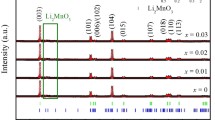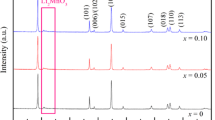Abstract
Among the cathode materials for advanced Li-ion batteries, nickel-rich Ni-Co-Mn (NCM) LiNixCoyMnyO2 (x > 0.5, x + 2y = 1) attracts great interest as promising materials owing to their high capacity, low cost, good cycling stability, safety and the fact that their stable capacity can be extracted by charging up to 4.3 V vs. Li. In this work, the effect of the synthesis route—freeze-drying, self-combustion, solid state and co-precipitation on the performance of NCM622 (LiNixCoyMnyO2, x = 0.6, y = 0.2) cathodes—in Li cells was thoroughly studied. The material prepared by freeze-drying exhibited superior electrochemical properties. The effect of in situ and ex situ Zr4+ cations doping on the electrodes’ capacity, stability and average voltage was also studied. Doping via a top–down, ex situ mode improved the performance in terms of capacity stabilization, whereas electrodes comprising materials that were doped via a bottom–up in situ approach showed stable average voltage upon prolonged cycling. These effects are discussed and explained herein.
Graphical abstract













Similar content being viewed by others
References
Etacheri V, Marom R, Elazari R, Salitra G, Aurbach D (2011) Challenges in the development of advanced Li-ion batteries: a review. Energy Environ Sci 4(9):3243–3262
Kim T, Song W, Son DY, Ono LK, Qi Y (2019) Lithium-ion batteries: outlook on present, future, and hybridized technologies. J Mater Chem A 7(7):2942–2964
Myung ST, Maglia F, Park KJ, Yoon CS, Lamp P, Kim SJ, Sun YK (2017) Nickel-rich layered cathode materials for automotive lithium-ion batteries: achievements and perspectives. ACS Energy Lett 2(1):196–223
Kim J, Lee H, Cha H et al (2018) Prospect and reality of Ni-rich cathode for commercialization. Adv Energy Mater 8
Schipper F, Erickson EM, Erk C, Shin JY, Chesneau FF, Aurbach D (2017) Review—Recent advances and remaining challenges for lithium ion battery cathodes. J Electrochem Soc 164(1):A6220–A6228. https://doi.org/10.1149/2.0351701jes
Bak SM, Hu E, Zhou Y, Yu X, Senanayake SD, Cho SJ, Kim KB, Chung KY, Yang XQ, Nam KW (2014) Structural changes and thermal stability of charged LiNixMnyCozO2 cathode materials studied by combined in situ time-resolved XRD and mass spectroscopy. ACS Appl Mater Interfaces 6(24):22594–22601. https://doi.org/10.1021/am506712c
Zheng J, Gu M, Genc A, Xiao J, Xu P, Chen X, Zhu Z, Zhao W, Pullan L, Wang C, Zhang JG (2014) Mitigating voltage fade in cathode materials by improving the atomic level uniformity of elemental distribution. Nano Lett 14(5):2628–2635. https://doi.org/10.1021/nl500486y
Ryu HH, Park KJ, Yoon CS, Sun YK (2018) Capacity fading of Ni-rich Li[NixCoyMn1-x-y]O2 (0.6 ≤ x ≤ 0.95) cathodes for high-energy-density lithium-ion batteries: bulk or surface degradation? Chem Mater 30(3):1155–1163. https://doi.org/10.1021/acs.chemmater.7b05269
Chen Z, Kim GT, Guang Y, Bresser D, Diemant T, Huang Y, Copley M, Behm RJ, Passerini S, Shen Z (2018) Manganese phosphate coated Li[Ni0.6Co0.2Mn0.2]O2 cathode material: towards superior cycling stability at elevated temperature and high voltage. J Power Sources 402:263–271. https://doi.org/10.1016/j.jpowsour.2018.09.049
Zhao W, Zheng J, Zou L, Jia H, Liu B, Wang H, Engelhard MH, Wang C, Xu W, Yang Y, Zhang JG (2018) High voltage operation of Ni-rich NMC cathodes enabled by stable electrode/electrolyte interphases. Adv Energy Mater 8(19):8. https://doi.org/10.1002/aenm.201800297
Bai Y, Li Y, Wu C, Lu J, Li H, Liu Z, Zhong Y, Chen S, Zhang C, Amine K, Wu F (2015) Lithium-rich nanoscale Li1.2Mn0.54Ni0.13Co0.13O2 cathode material prepared by co-precipitation combined freeze drying (CP-FD) for lithium-ion batteries. Energy Technol 3(8):843–850. https://doi.org/10.1002/ente.201500030
Liang L, Du K, Peng Z et al (2014) Co-precipitation synthesis of Ni0.6Co0.2Mn0.2(OH)2 precursor and characterization of LiNi0.6Co0.2Mn0.2O2 cathode material for secondary lithium batteries. Electrochim Acta 130:82–89. https://doi.org/10.1016/j.electacta.2014.02.100
Liang L, Du K, Lu W et al (2014) Synthesis and characterization of concentration-gradient LiNi0.6Co0.2Mn0.2O2 cathode material for lithium ion batteries. J Alloys Compd 613:296–305. https://doi.org/10.1016/j.jallcom.2014.05.027
Zheng Z, Guo XD, Chou SL, Hua WB, Liu HK, Dou SX, Yang XS (2016) Uniform Ni-rich LiNi0.6Co0.2Mn0.2O2 porous microspheres: facile designed synthesis and their improved electrochemical performance. Electrochim Acta 191:401–410. https://doi.org/10.1016/j.electacta.2016.01.092
Zhang Y, Cao H, Zhang J, Xia B (2006) Synthesis of LiNi0.6Co0.2Mn0.2O2 cathode material by a carbonate co-precipitation method and its electrochemical characterization. Solid State Ionics 177(37-38):3303–3307. https://doi.org/10.1016/j.ssi.2006.09.008
Li T, Li X, Wang Z, Guo H, Peng W, Zeng K (2015) Electrochemical properties of LiNi0.6Co0.2Mn0.2O2 as cathode material for Li-ion batteries prepared by ultrasonic spray pyrolysis. Mater Lett 159:39–42. https://doi.org/10.1016/j.matlet.2015.06.075
Yue P, Wang Z, Peng W, Li L, Guo H, Li X, Hu Q, Zhang Y (2011) Preparation and electrochemical properties of submicron LiNi0.6Co0.2Mn0.2O2 as cathode material for lithium ion batteries. Scr Mater 65(12):1077–1080. https://doi.org/10.1016/j.scriptamat.2011.09.020
Xia YF, Nie M, Wang ZB, Yu FD, Zhang Y, Zheng LL, Wu J, Ke K (2015) Structural, morphological and electrochemical investigation of LiNi0.6Co0.2Mn0.2O2 cathode material synthesized in different sintering conditions. Ceram Int 41(9):11815–11823. https://doi.org/10.1016/j.ceramint.2015.05.150
Gan C, Hu X, Zhan H, Zhou Y (2005) Synthesis and characterization of Li1.2Ni0.6Co0.2Mn0.2O2+δ as a cathode material for secondary lithium batteries. Solid State Ionics 176(7-8):687–692. https://doi.org/10.1016/j.ssi.2004.10.021
Wang L, Wu B, Mu D, Liu X, Peng Y, Xu H, Liu Q, Gai L, Wu F (2016) Single-crystal LiNi0.6Co0.2Mn0.2O2 as high performance cathode materials for Li-ion batteries. J Alloys Compd 674:360–367. https://doi.org/10.1016/j.jallcom.2016.03.061
Ju X, Huang H, He W, Zheng H, Deng P, Li S, Qu B, Wang T (2018) Surfactant-assisted synthesis of high energy {010} facets beneficial to Li-ion transport kinetics with layered LiNi0.6Co0.2Mn0.2O2. ACS Sustain Chem Eng 6(5):6312–6320. https://doi.org/10.1021/acssuschemeng.8b00126
Penki TR, Nayak PK, Levi E, Grinblat J, Elias Y, Luski S, Markovsky B, Aurbach D (2018) Reaching highly stable specific capacity with integrated 0.6Li2MnO3:0.4LiNi0.6Co0.2Mn0.2O2 cathode materials. ChemElectroChem 5(8):1137–1146. https://doi.org/10.1002/celc.201701193
Lee SW, Kim H, Kim MS, Youn HC, Kang K, Cho BW, Roh KC, Kim KB (2016) Improved electrochemical performance of LiNi0.6Co0.2Mn0.2O2 cathode material synthesized by citric acid assisted sol-gel method for lithium ion batteries. J Power Sources 315:261–268. https://doi.org/10.1016/j.jpowsour.2016.03.020
Yue P, Wang Z, Guo H, Wu F, He Z, Li X (2012) Effect of synthesis routes on the electrochemical performance of Li[Ni 0.6Co0.2Mn0.2]O2 for lithium ion batteries. J Solid State Electrochem 16(12):3849–3854. https://doi.org/10.1007/s10008-012-1823-3
Eilers-Rethwisch M, Winter M, Schappacher FM (2018) Synthesis, electrochemical investigation and structural analysis of doped Li[Ni0.6Mn0.2Co0.2-xMx]O2 (x = 0, 0.05; M = Al, Fe, Sn) cathode materials. J Power Sources 387:101–107. https://doi.org/10.1016/j.jpowsour.2018.02.080
Liu S, Dang Z, Liu D, Zhang C, Huang T, Yu A (2018) Comparative studies of zirconium doping and coating on LiNi0.6Co0.2Mn0.2O2 cathode material at elevated temperatures. J Power Sources 396:288–296. https://doi.org/10.1016/j.jpowsour.2018.06.052
Schipper F, Dixit M, Kovacheva D, Talianker M, Haik O, Grinblat J, Erickson EM, Ghanty C, Major DT, Markovsky B, Aurbach D (2016) Stabilizing nickel-rich layered cathode materials by a high-charge cation doping strategy: zirconium-doped LiNi0.6Co0.2Mn0.2O2. J Mater Chem A 4(41):16073–16084. https://doi.org/10.1039/c6ta06740a
Xue L, Li Y, Xu B, Chen Y, Cao G, Li J, Deng S, Chen Y, Chen J (2018) Effect of Mo doping on the structure and electrochemical performances of LiNi0.6Co0.2Mn0.2O2 cathode material at high cut-off voltage. J Alloys Compd 748:561–568. https://doi.org/10.1016/j.jallcom.2018.03.192
Sun H-B, Zhou Y-X, Zhang L-L, Yang XL, Cao XZ, Arave H, Fang H, Liang G (2017) Investigations on Zr incorporation into Li3V2(PO4)3/C cathode materials for lithium ion batteries. Phys Chem Chem Phys 19(7):5155–5162. https://doi.org/10.1039/c6cp07760a
Schipper F, Bouzaglo H, Dixit M et al (2018) From surface ZrO2 coating to bulk Zr doping by high temperature annealing of nickel-rich lithiated oxides and their enhanced electrochemical performance in lithium ion batteries. Adv Energy Mater 8. https://doi.org/10.1002/aenm.201701682
Wu Z, Ji S, Hu Z, Zheng J, Xiao S, Lin Y, Xu K, Amine K, Pan F (2016) Pre-lithiation of Li(Ni1-x-yMnxCoy)O2 materials enabling enhancement of performance for Li-ion battery. ACS Appl Mater Interfaces 8(24):15361–15368. https://doi.org/10.1021/acsami.6b03730
Liu W, Li X, Xiong D et al (2018) Significantly improving cycling performance of cathodes in lithium ion batteries: the effect of Al2O3 and LiAlO2 coatings on LiNi0.6Co0.2Mn0.2O2. ArticleInfo. https://doi.org/10.1016/j.nanoen.2017.11.010
Shim JH, Kim YM, Park M, Kim J, Lee S (2017) Reduced graphene oxide-wrapped nickel-rich cathode materials for lithium ion batteries. ACS Appl Mater Interfaces 9(22):18720–18729. https://doi.org/10.1021/acsami.7b02654
Liu S, Zhang C, Su Q, Li L, Su J, Huang T, Chen Y, Yu A (2017) Enhancing electrochemical performance of LiNi0.6Co0.2Mn0.2O2 by lithium-ion conductor surface modification. Electrochim Acta 224:171–177. https://doi.org/10.1016/j.electacta.2016.12.024
Huang Z, Wang Z, Jing Q, Guo H, Li X, Yang Z (2016) Investigation on the effect of Na doping on structure and Li-ion kinetics of layered LiNi0.6Co0.2Mn0.2O2 cathode material. Electrochim Acta 192:120–126. https://doi.org/10.1016/j.electacta.2016.01.139
Xu B, Fell CR, Chi M, Meng YS (2011) Identifying surface structural changes in layered Li-excess nickel manganese oxides in high voltage lithium ion batteries: a joint experimental and theoretical study. Energy Environ Sci 4(6):2223–2233. https://doi.org/10.1039/c1ee01131f
Huang Z, Wang Z, Zheng X, Guo H, Li X, Jing Q, Yang Z (2015) Effect of Mg doping on the structural and electrochemical performance of LiNi0.6Co0.2Mn0.2O2 cathode materials. Electrochim Acta 182:795–802. https://doi.org/10.1016/j.electacta.2015.09.151
Xu L, Zhou F, Kong J, Zhou H, Zhang Q, Wang Q, Yan G (2018) Influence of precursor phase on the structure and electrochemical properties of Li(Ni0.6Mn0.2Co0.2)O2 cathode materials. Solid State Ionics 324:49–58. https://doi.org/10.1016/j.ssi.2018.06.010
Zhao T, Chen S, Li L, Zhang X, Chen R, Belharouak I, Wu F, Amine K (2013) Synthesis, characterization, and electrochemistry of cathode material Li[Li0.2Co0.13Ni0.13Mn0.54]O2 using organic chelating agents for lithium-ion batteries. J Power Sources 228:206–213. https://doi.org/10.1016/j.jpowsour.2012.11.099
Funding
This work was supported in part by the Israel Committee for High Education and the Israeli Prime Minister office in the framework of the INREP project.
Author information
Authors and Affiliations
Corresponding author
Additional information
Publisher’s note
Springer Nature remains neutral with regard to jurisdictional claims in published maps and institutional affiliations.
Supplementary information
ESM 1
(PDF 2.38 mb)
Rights and permissions
About this article
Cite this article
Penki, T.R., Gilady, S., Nayak, P.K. et al. The effect of synthesis and zirconium doping on the performance of nickel-rich NCM622 cathode materials for Li-ion batteries. J Solid State Electrochem 25, 1513–1530 (2021). https://doi.org/10.1007/s10008-021-04933-x
Received:
Revised:
Accepted:
Published:
Issue Date:
DOI: https://doi.org/10.1007/s10008-021-04933-x




